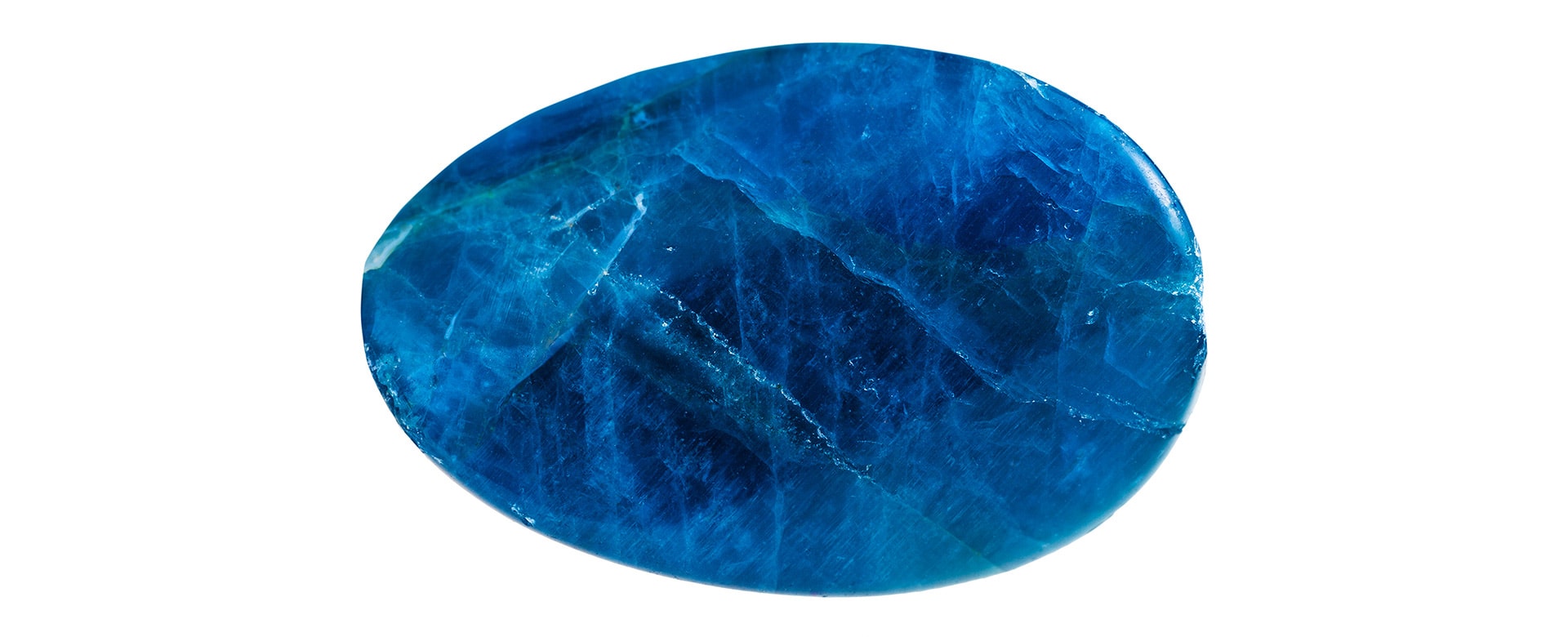Article Highlights
- Kyanite, a blue aluminosilicate mineral, originates from aluminium-rich metamorphic pegmatites and sedimentary rocks.
- It is known for its anisotropic nature with varying hardness depending on its crystallographic direction.
- Exceptional Blue Kyanite is used to create stunning cabochons, faceted stones, and beads.
- While Blue Kyanite may resemble blue sapphire, they have different physical properties.
- Despite attempts to synthesize it in the 1970s, genuine Blue Kyanite’s abundance and the difficulty of cutting make synthetic versions unlikely in the jewelry market.
Imagine delving deep into Earth’s crust, where the pressure is immense, and the temperature is scorching. Amidst this intense environment, the breathtakingly beautiful Kyanite is formed. Found mainly in aluminium-rich metamorphic pegmatites and sedimentary rocks, Blue Kyanite truly symbolizes the magic and mystery hidden beneath the Earth’s crust.
Now, here’s a mind-boggling fact: Blue Kyanite exhibits a unique feature called anisotropism, meaning its hardness varies depending on its crystallographic direction. So, a Blue Kyanite crystal could be quite hard in one direction and remarkably soft in another.
Kyanite’s Diverse Homes: Occurrence in Various Geological Niches
You’d expect such a unique mineral to be found only in rare, exotic locations, right? Well, guess what? Kyanite is everywhere! It’s in biotite gneiss, mica schist, hornfels, granite, pegmatites, and even quartz veins. From Manhattan schist, a rock formed under extreme pressure during the Pangaea supercontinent assembly, to the pegmatites of the Appalachian Mountains and Minas Gerais in Brazil, Kyanite does get around!
And if you thought that was all, think again! Kyanite has even managed to find its way into eclogites, a dense, green rock formed at the Earth’s highest pressure environments. However, these occurrences are rarer, making them even more intriguing.
The Evolutionary Journey: Transformation into Andalusite and Sillimanite
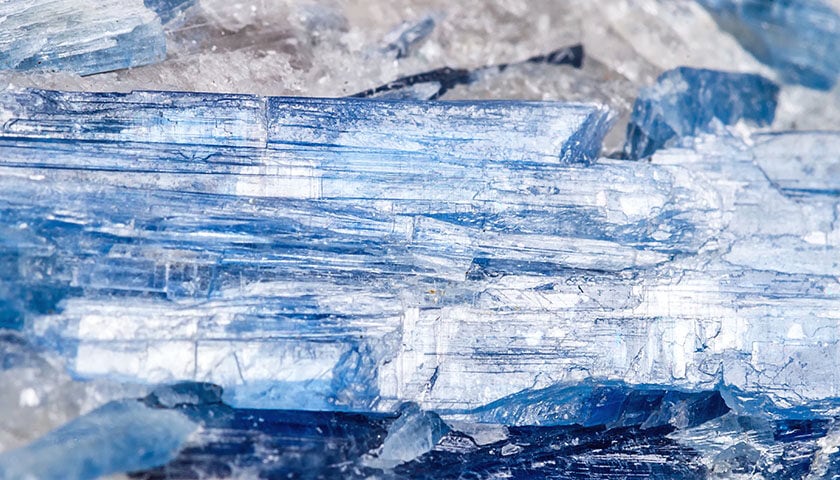
Kyanite is part of a fascinating trio of polymorphs. Picture these three minerals – Kyanite, andalusite, and sillimanite. They all have the same chemical composition, Al2SiO5, but what separates them is their different, distinct crystal structures.
The interesting part is, these three polymorphs undergo changes based on the surrounding temperature and pressure. Kyanite is most stable under high pressure, andalusite under lower temperature and pressure, and sillimanite under higher temperature and lower pressure. It’s like a dynamic, geological dance where each mineral takes the lead under specific conditions.
Historical Footsteps: A Tribute to Abraham Gottlieb Werner
Taking a step back in time, let’s give a nod to Abraham Gottlieb Werner, the man who named Kyanite in 1789. The term ‘Kyanite’ has its roots in the Ancient Greek word κύανος, which translates into English as kyanos or kuanos, and means “dark blue.” This allusion to its captivating color has since become synonymous with this extraordinary mineral.
A Geologist’s Best Friend: The Index Mineral
For geologists, Blue Kyanite plays an essential role. Its presence in metamorphic rocks is a beacon of high-pressure metamorphism, making it an invaluable index mineral. It’s like having a secret decoder ring that helps geologists understand the history and formation of the Earth’s crust.
Across the Globe: Kyanite’s Worldwide Presence
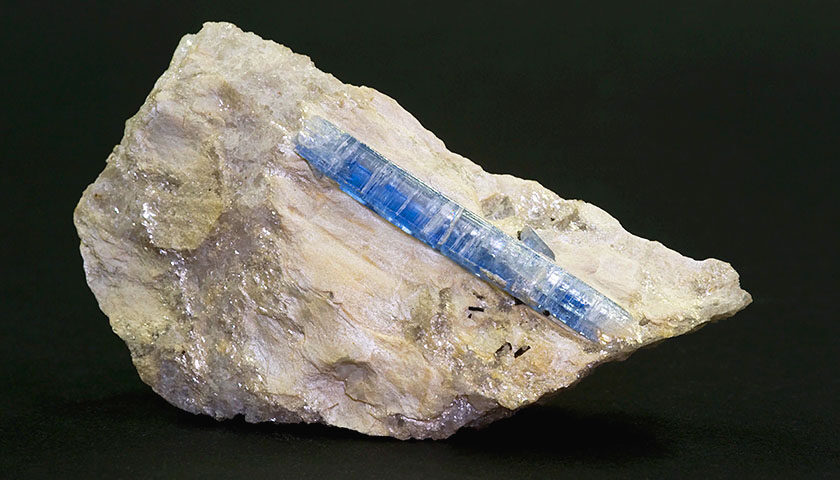
It’s time for a trip around the world, from the comforts of your chair, of course! Blue Kyanite has made its mark globally. In the United States, it’s found in places like Connecticut, Georgia, Massachusetts, North Carolina, Vermont, and Virginia.
Venturing into South America, Brazil boasts large blue and blue-green Kyanite crystals. Further afield, in Africa, Kenya and Mozambique, have an abundance of Kyanite with a stunning blue color. The crystal also graces Europe, specifically in Switzerland and Austria, Asia – India, Myanmar, and Nepal, and in the island nation of Madagascar. It’s a real globe trotter!
A Glimpse into the World of Blue Kyanite
With its enchanting blue color, fascinating geological properties, and wide-ranging global occurrence, Blue Kyanite tells a compelling story of metamorphic transformations deep within Earth’s crust. This captivating tale of Kyanite’s journey encourages us to delve deeper, explore further, and lose ourselves in the enchanting world of geology.
The Gemstone Potential of Blue Kyanite
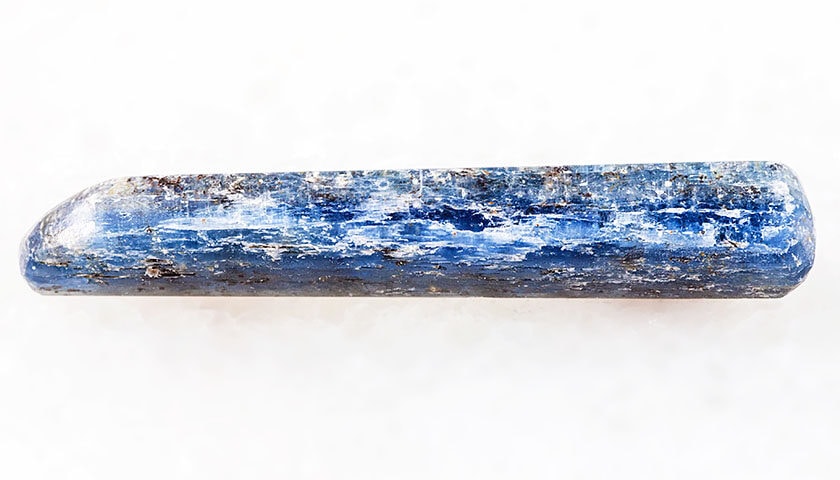
Imagine gazing at a magnificent piece of jewelry, its centerpiece a gem of such compelling blue that it seems to embody the vastness of the ocean and the infinite expanse of the sky. That’s the allure of Blue Kyanite as a gemstone.
When we get high-quality, beautifully colored Blue Kyanite, we can cut it into alluring cabochons and faceted stones, perfect for rings, earrings, pendants, and an array of other jewelry. It’s also used to craft striking beads, often flat due to Kyanite’s naturally thin, bladed formation.
Crafting the Gems: A Skillful Challenge
Working with Blue Kyanite is a test of skill and patience. Here’s the deal: it has two drastically different hardnesses. On the Mohs scale, it scores about 4.5 parallel to its length, but across the width of the blade, it rockets up to 6.5 to 7.0! Cutting Blue Kyanite into the desired shape requires not just a cutter but a master craftsman.
Sapphire’s Blue Cousin?
Now, you may have heard some chatter about Blue Kyanite being touted as a blue sapphire substitute. Sure, there are resemblances in color, but experienced gemologists can tell them apart without a second glance. Sapphire and Blue Kyanite have different refractive indices, optic character, and specific gravity values. And of course, their hardness differs too, though scratch testing isn’t recommended on finished gems.
If you’re mulling over choosing Blue Kyanite as a sapphire alternative, keep in mind that although it’s less durable, it’s also significantly cheaper.
Synthetic Blue Kyanite

Back in the 1970s, scientists managed to synthesize Blue Kyanite. Yet, given the challenges of cutting this mineral, it’s improbable that a synthetic version would gain traction in the jewelry market. Moreover, Blue Kyanite isn’t a rare mineral and is widely used in industries like abrasives, automotive brake materials, ceramics, and electronics.
You might stumble upon so-called “synthetic Kyanites” online, but these are likely just imitations. The term “synthetic” here is probably being used to mean “not real.”
From Small Gems to Impressive Exhibits
Blue Kyanite gemstones can range from dainty jewels to significantly sized exhibits. Faceters have successfully cut gems up to about 20 carats, although stones over 5 carats are rarely completely clean. Many of these stones originate from Brazil and Africa.
Some striking examples of Blue Kyanite’s potential as a gemstone can be found in prestigious collections around the world. The Smithsonian Institution houses a stunning 10.7 carat blue specimen from Brazil, while the Devonian Group in Calgary showcases a 14.0 carat blue gem from Africa. The Royal Ontario Museum outdoes them all with a jaw-dropping 40.26 carat rectangular step-cut gem from Brazil.
The Meaning and Symbolism of Blue Kyanite
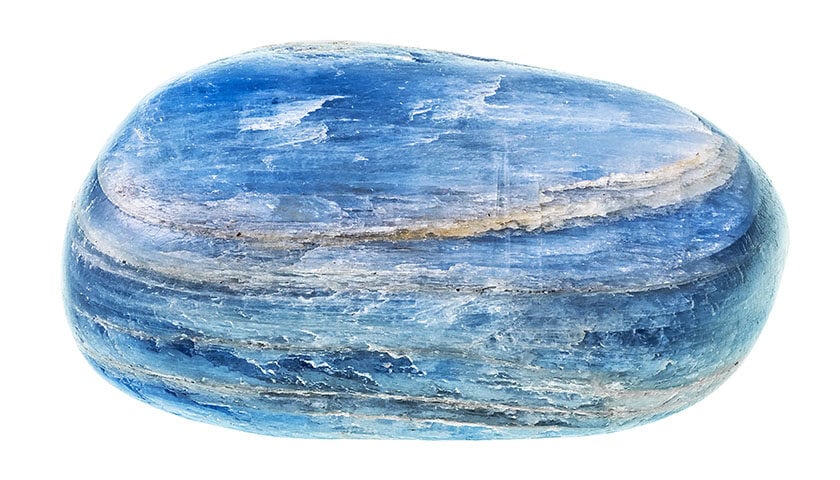
- Blue Kyanite has a profound connection with tranquility, balance, and understanding.
- Known as a ‘stone of attunement’, it symbolizes alignment and healing.
- Blue Kyanite fosters self-expression and communication, making it associated with the throat chakra.
Imagine standing on a serene beach, gazing at the vastness of the ocean. Its rhythmic waves wash over the shore, bringing a sense of calm and balance. This tranquil scene is the essence of Blue Kyanite. With its rich blue hues reminiscent of the deepest oceans, this gemstone has long been associated with tranquility, balance, and understanding.
Known as the ‘stone of attunement,’ Blue Kyanite beautifully embodies alignment and healing. It is symbolic of our journey to self-realization, helping us tune into our inner selves and find harmony within our hearts and minds. Just as the ocean connects distant lands, Blue Kyanite helps us connect with our deepest thoughts and emotions, enabling us to understand ourselves better.
In the realm of chakras, Blue Kyanite has a close relationship with the throat chakra, the energy center associated with communication. As such, it is seen as a talisman of self-expression, encouraging open and honest communication. Imagine it as a lighthouse guiding your thoughts and words, helping you navigate the vast seas of conversation and connection.
As you delve deeper into Blue Kyanite’s symbolic ocean, you’ll discover that it’s also associated with a sense of protection and healing. Like the sea, it envelops us in its calming embrace, providing a sanctuary where our worries can ebb away, and our spirits can rejuvenate.
Blue Kyanite Healing Properties

Emotional Benefits
- Blue Kyanite provides emotional healing, promoting tranquility and inner peace.
- It helps clear emotional blockages, leading to healthier relationships and self-expression.
- Blue Kyanite fosters empathy and compassion, aiding emotional understanding.
Imagine feeling like you’re walking in a lush forest, dappled sunlight peeking through the canopy. A cool breeze whispers past, washing over you with a sense of calm. You feel connected, balanced, at peace. This serene energy is the essence of Blue Kyanite’s emotional benefits.
Blue Kyanite is a soothing balm for turbulent emotions. Its cool, calming energy is like a river, flowing through your emotional landscape, soothing worries, calming anger, and quieting restlessness. It’s the comforter when times get tough, lending you the resilience to ride out emotional storms.
Have you ever felt like your feelings are a tangled knot, too complex to unravel? Blue Kyanite works like a gentle detangler, unravelling emotional blockages, easing frustration, and opening the channels of self-expression. It helps us communicate more effectively, fostering healthier relationships and happier hearts.
Like a mirror reflecting the moon’s soft glow, Blue Kyanite also helps foster empathy and compassion. It aids us in understanding others’ emotions, creating deeper connections and a more empathetic worldview. It’s the friend that whispers, “Hey, I get you,” helping you to extend that understanding to others.
Spiritual Benefits
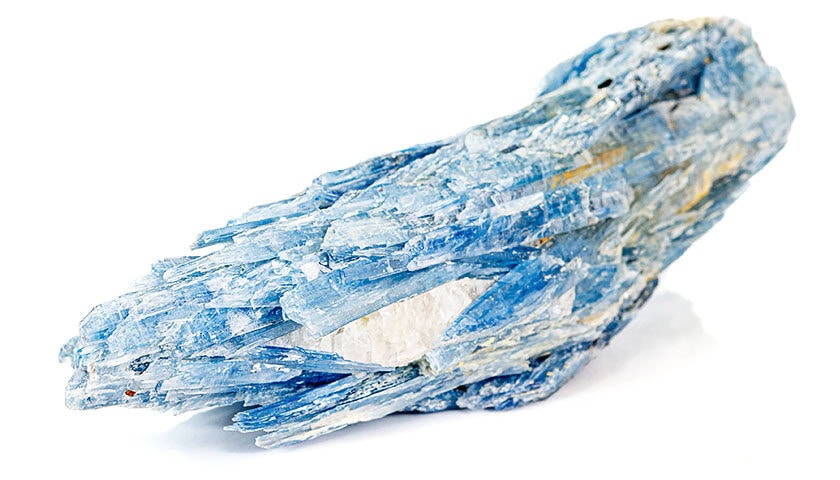
- Blue Kyanite is a spiritual stone of attunement and intuition.
- It aids in aligning and balancing the chakras.
- Blue Kyanite promotes spiritual growth and self-discovery.
Take a moment to picture a clear, starry night, where constellations paint stories across the sky. Blue Kyanite’s spiritual benefits are like those stars – a guide on the journey within, helping illuminate our paths and enrich our inner lives.
Known as the ‘stone of attunement,’ Blue Kyanite is like a tuning fork for the soul. It helps attune our intuition and heighten our spiritual awareness, allowing us to perceive beyond the physical realm. It’s like a pair of spiritual binoculars, bringing the universe into focus.
Ever feel like you’re juggling too many balls at once? Blue Kyanite is your spiritual balancer. It aligns and balances the chakras, smoothing out any energy hiccups and creating a free-flowing spiritual highway. It’s your soul’s compass, helping you navigate your inner world with ease.
As we traverse our spiritual journeys, growth and self-discovery become vital. Blue Kyanite is a booster for these quests. It aids in unlocking hidden aspects of oneself, fostering growth and promoting spiritual evolution. Consider it your trusty flashlight, illuminating the nooks and crannies of your inner self, helping you discover who you really are.
Blue Kyanite Metaphysical Properties
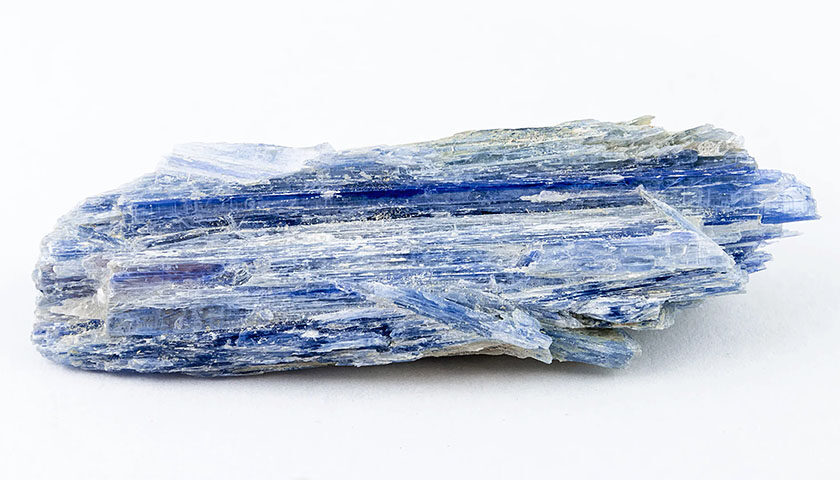
- Blue Kyanite resonates with the Throat and Third-Eye Chakras.
- It is connected with the zodiac signs of Gemini and Pisces.
- It facilitates intuitive and psychic abilities.
- Blue Kyanite aids in dream recall and visualization.
Close your eyes and imagine a cool, serene mountain lake reflecting the azure sky. Its calm surface is undisturbed, harmonious, and perfectly balanced. In the world of metaphysical healing, Blue Kyanite carries a similar energy.
Blue Kyanite, with its alluring blue color reminiscent of the sky at twilight, is renowned for its ability to align the chakras. Picture your chakras as spinning wheels of energy, each with its own color and vibrational frequency. Occasionally, life’s challenges cause these wheels to wobble, leading to imbalance. Blue Kyanite is like an expert mechanic for these wheels, aligning them to spin in harmony. It helps bring equilibrium and serenity, allowing your energy to flow freely.
Consider Blue Kyanite your intuitive whisperer. It’s been long appreciated for its ability to amplify intuitive and psychic abilities. If you’ve ever experienced those moments of uncanny intuition, like a sixth sense nudging you in the right direction, Blue Kyanite helps you tune into this inner guidance. It’s like a trusted old radio, helping you tune into your inner frequency with better reception and clarity.
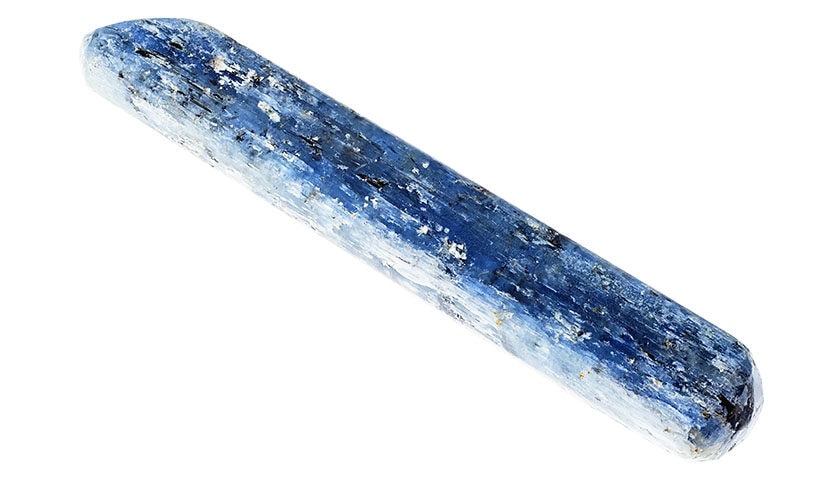
Dreams can be mysterious, can’t they? They’re like cryptic messages from our subconscious. Blue Kyanite is a dream-catcher of sorts, aiding in dream recall. It’s as if you’re armed with a cosmic DVR, able to remember and understand the cryptic messages your dreams convey.
Now, let’s add a pinch of visualization to this metaphysical cocktail. Ever had a goal, an aspiration, or an image of your perfect future? Blue Kyanite acts as your visualization assistant. It helps crystalize these images in your mind’s eye, making them vivid and powerful. It’s like a personal movie director, helping you visualize your dreams and goals with Oscar-worthy clarity.
Blue Kyanite, Chakras and Zodiac Connection
Take a moment to think about the gentle hum of a finely tuned orchestra, the harmony that fills the air when every instrument is perfectly synchronized. Just like an orchestra, our body too thrives in harmony, and that harmony is maintained by our energy centers, the chakras. Blue Kyanite, with its soothing blue hue and calming energy, is a conductor of this harmony, particularly resonating with the Throat and Third-Eye Chakras.
The Throat Chakra, or Vishuddha, is the seat of communication and expression. When it’s blocked, we can struggle to find our voice, both metaphorically and literally. Blue Kyanite, like a skilled speech therapist, helps clear these blockages. It prompts us to speak our truth, articulate our thoughts, and express ourselves confidently.
Now, move your attention to your Third-Eye Chakra, or Ajna. This chakra is the control center of intuition and foresight. Sometimes, this ‘third eye’ may get clouded, causing us to lose sight of our path. But fear not, Blue Kyanite is like a gentle hand that wipes this clouded lens clean. It enhances our intuition and inner wisdom, allowing us to see beyond the superficial.
Blue Kyanite also finds a connection in the cosmos, particularly with the zodiac signs of Gemini and Pisces. If you’re a Gemini, you might know that your sign is often associated with communication and intellect. Blue Kyanite can help you channel this communicative energy effectively, facilitating clearer and more constructive expression.
For the dreamy Pisces, Blue Kyanite can be an emotional anchor. Pisces are known for their deep emotional and intuitive capabilities. Blue Kyanite helps in grounding these energies, preventing the Pisces from getting swept away in the current of their deep feelings.
How to Use Blue Kyanite: Meditation, Feng Shui, and Beyond

- Blue Kyanite can enhance your meditation practice.
- It is an ideal crystal to incorporate in your Feng Shui strategies.
- Blue Kyanite can be used effectively in your home and workplace.
A Symphony of Silence: Meditating with Blue Kyanite
Meditation can be a journey, an exploration of your inner world. And just like any journey, it can be enriched by a trusty companion. Enter Blue Kyanite, your spiritual sherpa guiding you through the mountains of the mind.
As you prepare to meditate, hold your Blue Kyanite gemstone in your hand, feeling its cool, soothing energy. Close your eyes, and let this calming energy seep in, untangling your thoughts and easing the rhythm of your breath. Blue Kyanite resonates with the Third Eye and Throat Chakras, enhancing your intuition and communication, making your inward journey smoother and more insightful.
The Art of Energy: Embracing Blue Kyanite in Feng Shui
Feng Shui is the ancient art of harmonizing energy in our surroundings. The inclusion of Blue Kyanite in your Feng Shui tactics can be like inviting a warm, gentle breeze into your living space.
Place Blue Kyanite in the wealth area (southeast) of your home or office, to invite abundance and prosperity. Positioning it in your knowledge and wisdom area (northeast) can enhance clarity of thought and decision-making. Remember, in Feng Shui, intention is everything. As you position your Blue Kyanite, infuse it with your specific intention, be it peace, abundance, or clarity.
Crystal Comforts: Blue Kyanite in Your Home and Workplace
Beyond meditation and Feng Shui, Blue Kyanite is a versatile gem that can bring balance and harmony in your everyday environments. Place it near your computer at work to deflect stress and maintain a peaceful atmosphere. Keep a piece by your bedside table to ensure a restful sleep. You can even wear Blue Kyanite jewelry to carry its harmonious energy wherever you go.
Adorning Yourself with Blue Kyanite: A Journey of Style and Healing

Blue Kyanite Necklaces
Isn’t there something magical about necklaces? They nestle close to your heart, silently whispering their stories. Blue Kyanite necklaces are no different. Each bead or pendant serves as a symbol of tranquility, hanging close to your heart, infusing your aura with serenity. So next time you’re dressing up, let Blue Kyanite lend its soothing touch to your ensemble.
Blue Kyanite Rings
Rings have a powerful aura, symbolizing eternity and commitment. Imagine weaving that symbolism with the calming vibes of Blue Kyanite! Whether it’s an engagement ring, a statement piece, or just something to make your hands sparkle, Blue Kyanite rings are there to remind you of the endless flow of peace within you.
Blue Kyanite Bracelets
Bracelets can be so much more than a fashion accessory. A Blue Kyanite bracelet wrapped around your wrist can serve as a constant source of harmonizing energy. Each time you look at the glistening stones, let them remind you of your inner strength and serenity.
Blue Kyanite Pendants
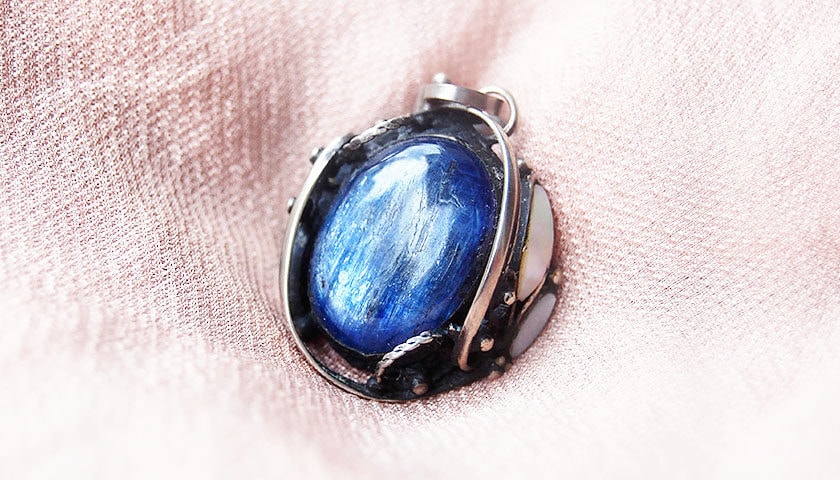
Imagine carrying a little piece of serenity with you, wherever you go. A Blue Kyanite pendant does just that. Nestled against your chest, this radiant gem will soothe your energy, while its entrancing blue hues catch everyone’s eye.
Blue Kyanite Earrings
Earrings are often the subtle, yet powerful finishing touch to an outfit. With Blue Kyanite earrings, you’re not just adding a dash of color, but a pinch of tranquility to your look. As the cool, blue gems sway gently with your every move, they whisper their tales of calm and balance into your ears.
Blue Kyanite Beads
Beads are the unsung heroes of the jewelry world. They hold the power to transform, whether threaded into a necklace, a bracelet, or a pair of earrings. String together Blue Kyanite beads, and you have a strand of serenity, ready to infuse peace and balance into your life.
Tuning Your Blue Kyanite: Cleansing and Charging for Optimal Energy Flow

Salt: A Natural Purifier
Salt has been used as a cleansing agent for centuries, in everything from food preservation to spiritual rituals. To cleanse your Blue Kyanite with salt, simply bury it in a bowl of sea salt overnight. Salt absorbs negative energy, allowing your gem to shine with its natural vibrancy. Just remember, salt can be corrosive, so always rinse your stone in lukewarm water afterward to remove any residual salt.
Sage and Incense: A Dance of Smoke
Ever seen smoke rise from sage or incense? It’s like watching negative energy being danced away. Passing your Blue Kyanite through sage smoke or incense not only cleanses it but also infuses it with a sense of calm and balance. However, always be cautious around open flames, and ensure proper ventilation to keep the smoke from becoming overwhelming.
Moonlit Recharge
The moon has long been associated with healing and rejuvenation. Imagine your Blue Kyanite basking under the cool, soothing moonlight, charging its energy reserves. An overnight moonlit bath, especially during a full moon, works wonders. The silvery beams gently infuse your stone with a soft, calming energy, priming it for future healing work.
Blue Kyanite Affirmations

Finding your Voice
Blue Kyanite, with its deep, oceanic blue hues and linear crystalline structures, is often associated with the Throat Chakra, a power center linked with self-expression and communication. When working with this gem, you may find affirmations such as “I speak my truth freely and openly” or “My voice is heard and respected” to be beneficial. These affirmations can help you tap into the stone’s potent energy, encouraging you to express your thoughts and feelings with confidence and clarity.
Boosting Intuition
Blue Kyanite also has a strong connection with the Third Eye Chakra, our center of intuition and inner wisdom. If you’re looking to enhance these areas of your life, try affirmations like “I trust my intuition and follow its guidance” or “My inner wisdom guides me to make the right choices.” Repeating these affirmations while meditating with your Blue Kyanite can open your mind to new insights and ideas, fostering a stronger sense of trust in your own intuition.
Fostering Calm and Balance
Known for its tranquil energy and ability to bring balance, Blue Kyanite is perfect for affirmations centered around peace and harmony. If you’re going through a challenging time, consider affirmations like “I am calm and centered” or “I welcome balance and tranquility into my life.” Such affirmations, combined with the soothing influence of Blue Kyanite, can help ease tension and create a peaceful mental space.
Promoting Healing and Growth
Lastly, as a powerful healing stone, Blue Kyanite can enhance affirmations focused on personal growth and transformation. Affirmations such as “I am open to positive change and growth” or “I am healing and becoming stronger each day” can be incredibly powerful. They can help you harness Blue Kyanite’s healing energy, accelerating your journey towards self-improvement.
The Many Shapes and Forms of Blue Kyanite
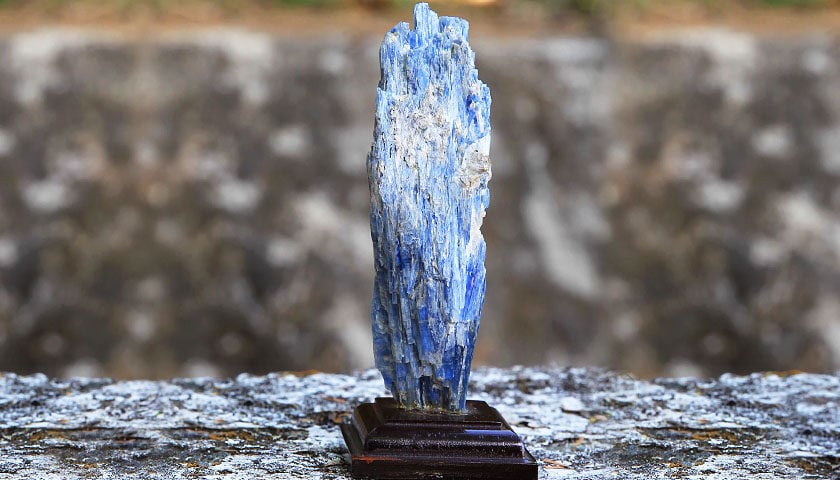
Tumbled into Tranquility: Blue Kyanite Tumbled Stones
Tumbled stones are a popular form for many gem lovers, and Blue Kyanite is no exception. Picture this: smooth, lustrous stones, their radiant blue hues gleaming under the light. The process of tumbling enhances the stone’s natural beauty and reveals a polish that’s a delight to touch. Blue Kyanite tumbled stones are perfect for those seeking a soothing talisman to carry in their pocket or to use during meditation.
Gleaming Gem: Blue Kyanite Polished Stones
Just imagine a Blue Kyanite stone, polished to perfection. The stone’s crystalline structure comes alive in the light, revealing its full spectrum of blue shades. Polished stones maintain the raw essence of Blue Kyanite while enhancing its allure with a glossy finish. They are often used as decorative pieces or held during mindfulness practices to tap into their tranquil energy.
Raw and Radiant: Blue Kyanite Rough Stones
Rough stones are Blue Kyanite in its purest form, right as Mother Earth intended. They retain the raw, rugged beauty of the crystal, with each piece unique in shape and form. Holding a rough Blue Kyanite stone can connect you to the stone’s primal energy and to the grounding forces of the Earth.
Universal Harmony: Blue Kyanite Spheres
A sphere represents unity, completeness, and infinite possibility. Blue Kyanite spheres carry these symbolic meanings. With their calm blue hues and smooth surfaces, these spheres are ideal for promoting peace and tranquility. They can be used in meditative practices or as an attractive addition to your sacred space.
Hearts Full of Love: Blue Kyanite Hearts
Blue Kyanite carved into heart shapes makes for a meaningful and unique symbol of love and emotional balance. These stones can be used to promote self-love, heal emotional wounds, or enhance relationships. A Blue Kyanite heart is more than just a stone—it’s a gentle reminder of the power of love.
Pyramids of Power: Blue Kyanite Pyramids
A pyramid’s four sides are said to represent the four elements—earth, air, fire, and water—while the point symbolizes the unifying force of spirit. Blue Kyanite pyramids can help channel this unity and balance into your life. These exquisite pieces can be used for energy work or as a focal point during meditation.
Wisdom and Guidance: Blue Kyanite Wands
Blue Kyanite wands, with their long, sleek form, are often used in energy healing practices. Their shape directs the flow of energy, enabling you to target specific areas or chakras. Whether you’re seeking clarity, balance, or communication, a Blue Kyanite wand can be a powerful tool in your spiritual journey.
Soothing to the Touch: Blue Kyanite Palm Stones
Shaped to fit perfectly in the palm of your hand, Blue Kyanite palm stones provide a tactile connection to the crystal’s soothing energy. They’re perfect for moments of stress, meditation, or just as a comforting companion throughout your day.
Cabochon Charms: Blue Kyanite Cabochons
Blue Kyanite cabochons—polished, rounded stones often used in jewelry—possess a mesmerizing beauty. With their domed shape and vibrant color, they catch the light in a way that truly showcases the depth and variety of blue found in this remarkable stone. Wearing a Blue Kyanite cabochon can be a delightful way to carry its calming energy with you wherever you go.
The Value of Vibrant Blue Kyanite
When it comes to acquiring a piece of Blue Kyanite, you’ll find a wide range of prices. This is due to factors such as size, quality, shape, and how it has been processed or cut. For small, tumbled stones or rough pieces, you may pay as little as $2-$5 per piece. Medium-sized, high-quality specimens or polished stones might range between $10-$50. Exceptionally large or superior quality pieces, especially those that have been crafted into jewelry or intricate shapes, can cost upwards of $100.
Blue Kyanite vs Blue Calcite
Blue Kyanite and Blue Calcite are two captivating blue-hued stones, but their differences are as compelling as their shared sapphire color.
Blue Calcite, with its soft and soothing baby-blue hue, is found across the globe and is a carbonate mineral with a Mohs hardness of 3, making it quite soft.
On the other hand, Blue Kyanite, known for its deeper azure to royal blue color, presents a unique attribute: differing hardness depending on the crystal orientation. A nesosilicate mineral, it has a hardness of 4.5 along the length and 6.5 to 7 across the width of the blade-like crystals.
Both stones carry a calming energy, but while Blue Calcite is known for aiding communication and alleviating anxiety, Blue Kyanite is reputed for balancing energy and promoting psychic abilities.
Value-wise, both stones are reasonably affordable, with Blue Calcite typically priced at $2-$10 per piece and Blue Kyanite ranging from $2 to $100 depending on the size and quality.
Blue Kyanite vs Lapis Lazuli
While Blue Kyanite evokes images of long, blade-like crystals, Lapis Lazuli presents an entirely different picture.
Lapis Lazuli, with its intense deep blue color speckled with golden pyrite, is a rock composed of several minerals, unlike the singular mineral of Blue Kyanite.
Its history goes back to ancient Egypt where it was prized for its beauty. Lapis Lazuli, with a hardness of 5-5.5, was traditionally used for ornamentation and in spiritual practices.
Blue Kyanite, with its energy-balancing properties and strong alignment with the throat and third-eye chakras, is more strongly linked to metaphysical practices today.
In terms of value, Lapis Lazuli, due to its historical and artistic significance, can range from $1-$100 per carat, while Blue Kyanite maintains a more modest range, typically between $2-$100 per piece.
Blue Kyanite vs Black Kyanite
Despite sharing the same mineral family, Blue Kyanite and Black Kyanite carry a stark color contrast.
While Blue Kyanite enchants with its blue shades, Black Kyanite crystals are darker and often formed in fan-like structures.
Black Kyanite is known for its grounding properties, often used for meditation and energy clearing. Blue Kyanite, conversely, is associated with high-frequency energy, helping to align chakras and enhance communication.
The price range for these two siblings varies, with Black Kyanite usually costing between $5-$25 per piece, while Blue Kyanite’s value fluctuates from $2-$100, depending on its form and quality.
Blue Kyanite vs Green Kyanite
Blue Kyanite and Green Kyanite may be of the same mineral family, but their appearances and energetic properties vastly differ.
While Blue Kyanite embodies shades of the sky and sea, Green Kyanite captures the lush vibrancy of a forest canopy.
Blue Kyanite aligns with the throat and third-eye chakras, aiding in communication and psychic abilities, while Green Kyanite connects with the heart chakra, promoting emotional balance.
Green Kyanite is slightly rarer than its blue sibling, commanding a slightly higher price, typically between $5-$100 per piece, whereas Blue Kyanite stays in the $2-$100 range.
Blue Kyanite vs Indigo Kyanite
Blue Kyanite and Indigo Kyanite share similar crystal structures, but their colors differentiate them.
Blue Kyanite is azure to royal blue, while Indigo Kyanite presents a deep, nearly purple-blue.
Both stones align with the third-eye chakra, but while Blue Kyanite is known for enhancing overall energy flow, Indigo Kyanite specifically aids in enhancing intuition and promoting spiritual awareness.
Indigo Kyanite is quite rare, and its price can range between $10-$200 per piece, compared to Blue Kyanite’s more modest $2-$100 range.
Blue Kyanite vs Sodalite
Both Blue Kyanite and Sodalite are blue gemstones that captivate with their alluring shades.
Sodalite, named for its high sodium content, typically exhibits rich, royal blue colors with white streaks. Unlike the varying hardness of Blue Kyanite, Sodalite has a consistent hardness of 5.5-6.
Known for its soothing energy, Sodalite is thought to promote peace and tranquility, while Blue Kyanite is reputed for its ability to balance energy.
In terms of value, Sodalite is relatively affordable, usually ranging from $1-$20 per piece, while Blue Kyanite can range between $2-$100 per piece.
Blue Kyanite vs Blue Topaz
Blue Kyanite and Blue Topaz may both carry the enchantment of blue, but they are quite different.
Blue Topaz, with its dazzling range from light sky blue to deep London blue, is a silicate mineral with a high hardness of 8. In contrast, Blue Kyanite is a softer gem with a striking blade-like crystal form.
Blue Topaz is traditionally connected to luxury and opulence, whereas Blue Kyanite is more tied to spiritual and emotional balance.
The price range for Blue Topaz can greatly vary, from $20 to $500 per carat depending on its color and quality, while Blue Kyanite, though enchanting in its own right, remains more affordable, ranging from $2-$100 per piece.
Blue Kyanite vs Sapphire
Though both are entrancingly blue, Sapphire and Blue Kyanite share few other similarities.
Sapphire, a precious gemstone, is a variety of corundum and has a high hardness of 9 on the Mohs scale. Its rich, deep blue color has made it a coveted stone throughout history. Blue Kyanite, on the other hand, has a unique blade-like crystal structure and varying hardness.
Sapphire is often associated with wisdom and divine favor, while Blue Kyanite is revered for balancing energy and enhancing communication.
When it comes to value, Sapphire’s price range can span $25 to $11,000 per carat depending on its quality, while Blue Kyanite remains far more affordable, with a range of $2-$100 per piece.
Blue Kyanite vs Tanzanite
Tanzanite and Blue Kyanite couldn’t be more different in their origins. Tanzanite, a blue-violet variety of zoisite, is found in only one place on Earth: near Mount Kilimanjaro in Tanzania. Blue Kyanite, however, is fairly common and found worldwide.
Both stones are known for their vivid blue color, but while Blue Kyanite is used for its reputed energy-balancing properties, Tanzanite is mostly a gemstone for jewelry.
Tanzanite, due to its rarity, can cost anywhere from $300 to $1,200 per carat, while Blue Kyanite ranges from $2-$100 per piece.
Blue Kyanite vs Labradorite
Both Labradorite and Blue Kyanite have a mystical aura about them. Labradorite, a feldspar mineral, is renowned for its stunning play of color, or labradorescence, which often includes shades of blue.
Blue Kyanite, with its long, blade-like crystals, also enchants with its beautiful blue hues. Labradorite is believed to awaken one’s inner spirit and intuition, while Blue Kyanite is associated with energy balance and enhanced communication.
Labradorite typically ranges from $10-$40 per piece, while Blue Kyanite can be found between $2-$100 per piece.
Blue Kyanite vs Azurite
Azurite and Blue Kyanite share a deep blue color but are otherwise distinct. Azurite, a copper carbonate mineral, has a deep, intense azure color, while Blue Kyanite displays various shades of blue.
Known for its use in pigments in ancient times, Azurite today is considered a stone of insight and vision. Blue Kyanite is reputed for its ability to align chakras and enhance communication.
While Azurite can range from $4-$60 per piece, Blue Kyanite’s price typically falls between $2-$100 per piece.
Blue Kyanite vs Blue Apatite
Blue Apatite and Blue Kyanite both captivate with their vibrant blues, but each has its own unique appeal. Blue Apatite, a calcium phosphate mineral, has a blue-green color reminiscent of tropical waters. Blue Kyanite, however, enchants with its beautiful gradient of blues.
Both stones are reputed for their metaphysical properties, with Blue Apatite associated with clarity and personal growth, and Blue Kyanite known for energy alignment and communication.
Blue Apatite can range from $1-$20 per piece, while Blue Kyanite’s price typically falls between $2-$100 per piece.
Blue Kyanite vs Aquamarine
Aquamarine, named for the Latin term ‘water of the sea,’ is well known for its stunning ocean-like blue color. Blue Kyanite, with its varying shades of blue, also reminds one of the sea.
Aquamarine is a variety of beryl and is associated with tranquility and protection in travel over water. Blue Kyanite, in contrast, is reputed for aligning the body’s energy centers.
Aquamarine’s price can range vastly, from $20 to $1,000 per carat depending on its quality, while Blue Kyanite remains more affordable, from $2-$100 per piece.
Blue Kyanite vs Celestite
Celestite, with its name derived from the Latin word for ‘heavenly,’ and Blue Kyanite both evoke images of serene skies.
Celestite is known for its pale, cool blue color and is associated with divine connection and serenity. Blue Kyanite, though varying in its shades of blue, is also connected with tranquility through its purported chakra-aligning properties.
Celestite generally ranges from $5-$50 per piece, while Blue Kyanite’s price falls between $2-$100 per piece.
Blue Kyanite vs Blue Lace Agate
Blue Lace Agate, with its light blue and white banding, and Blue Kyanite, with its gradient of blues, both emit a calming energy.
Blue Lace Agate is associated with communication and clarity, while Blue Kyanite is believed to align energies and enhance communication.
When it comes to cost, Blue Lace Agate usually ranges from $1-$25 per piece, while Blue Kyanite varies from $2-$100 per piece.
Blue Kyanite vs Dumortierite
Dumortierite and Blue Kyanite, both boasting their distinct blues, each bring something different to the table.
Dumortierite is known for its deep violet-blue color and is associated with patience and intellectual stimulation.
Blue Kyanite, with its varying shades of blue, is reputed for alignment of energy and enhancing communication.
When it comes to value, Dumortierite can range from $2-$20 per piece, while Blue Kyanite ranges from $2-$100 per piece.
Blue Kyanite Crystal Combinations
Blue Kyanite and Black Tourmaline: The Power Pair
Imagine having an energy supercharger and a protective shield working together! That’s the potent mix you get when you combine Blue Kyanite, the aligner, and Black Tourmaline, the protector. Their pairing amplifies the individual abilities of each stone and creates a synergy that is potent. Black Tourmaline is said to guard against negative energies, while Blue Kyanite helps to align all the chakras, keeping you in balance. Together, they promote a protective and harmonious energy field, making this combination a favorite for many energy healers.
Blue Kyanite and Rose Quartz: A Symphony of the Heart
Combining the soothing energies of Rose Quartz, the stone of unconditional love, with the harmonizing capabilities of Blue Kyanite creates a calming symphony for the heart. Rose Quartz’s gentle, nurturing vibes complement the alignment qualities of Blue Kyanite, which opens up avenues for love and compassion. It’s like a love song that helps to harmonize your energy centers, making you more receptive to giving and receiving love.
The Dream Team: Blue Kyanite and Amethyst
Paired together, Blue Kyanite and Amethyst make a dynamic duo for dream recall and spiritual communication. Blue Kyanite’s ability to balance and align chakras complements Amethyst’s properties of enhancing intuition and spiritual growth. It’s like having a personal translator for your dreams and spiritual journeys!
Blue Kyanite and Labradorite: The Visionaries
Combine the alignment properties of Blue Kyanite with Labradorite’s reputation for unleashing the power of imagination, and you’ve got a powerhouse combination for vision and insight. Together, these stones work to align the chakras and enhance intuitive abilities, creating a clear channel for innovative ideas and visions.
Lapis Lazuli and Blue Kyanite: The Communicators
Pairing Blue Kyanite with Lapis Lazuli, a stone known for truth and enlightenment, is like having the universe’s best communication setup. These stones enhance your ability to express your deepest truths, promoting honesty, and encouraging clear and effective communication.
Blue Kyanite and Moldavite: The Transformers
When you combine the alignment properties of Blue Kyanite with Moldavite, a stone known for intense frequencies and high vibration, you get a catalyst for change. Together, these stones create a strong force for personal growth and transformation, helping you to align with your highest self.
Citrine and Blue Kyanite: The Manifestation Magnets
Imagine the alignment of Blue Kyanite and the abundance-bringing energy of Citrine working together. You have a powerful combination that not only aligns your chakras but also attracts prosperity and success. It’s like tuning your energy to the frequency of abundance!
Clear Quartz and Blue Kyanite: The Amplifiers
Clear Quartz, often dubbed the “master healer,” is known for amplifying energy and thought. Pair this powerhouse with the aligning properties of Blue Kyanite, and you’ve got an impressive combination to elevate your vibrational frequency, essentially turbo-charging your intentions and goals.
Blue Kyanite and Moonstone: The Intuition Boosters
Moonstone, with its luminous sheen and feminine energy, is considered a stone of intuition and insight. When teamed with Blue Kyanite, the duo creates a wonderful balance, enabling one to delve deeper into the subconscious and enhance intuitive abilities, perfect for those seeking to harness their inner wisdom.
Sillimanite and Blue Kyanite: The Kindred Spirits
Interestingly, both Sillimanite and Blue Kyanite are aluminum silicate minerals. Thus, they share similar energy vibes and metaphysical properties. When combined, these “kindred spirits” work harmoniously to align the chakras and stimulate intuitive insight, making this a potent pairing for self-discovery and growth.
Garnet and Blue Kyanite: The Energizers
The vitality-boosting properties of Garnet paired with the chakra-aligning features of Blue Kyanite create an energetic duo that stimulates vigor and endurance. This combination is perfect for those seeking to re-energize and stay motivated, acting like a natural caffeine boost for your energy centers!
Aquamarine and Blue Kyanite: The Peace Bringers
When the calming energies of Aquamarine meet the aligning qualities of Blue Kyanite, you get a beautiful blend designed for tranquility. This pair promotes a peaceful, soothing vibe that calms the mind, making it ideal for those seeking serenity and relief from stress.
Selenite and Blue Kyanite: The Cleanse & Charge Combo
Imagine combining Selenite, a crystal known for cleansing and charging other stones, with Blue Kyanite, which never retains negative energy and doesn’t need to be cleansed. This combo ensures an environment filled with constantly vibrating, high-frequency energy, perfect for maintaining a positive and harmonious space.
Sodalite and Blue Kyanite: The Truth Seekers
Sodalite, the stone of logic and truth, paired with the chakra-aligning Blue Kyanite creates an excellent combo for those on a quest for truth and understanding. It helps align your perception and aids in expressing your truths with clarity.
Andalusite and Blue Kyanite: The Perspective Shifters
Pairing Blue Kyanite with Andalusite, known for its ability to provide a wider perspective on situations, can help align your energy centers and broaden your point of view. This combo is perfect for those facing complex challenges and seeking a clearer perspective.
Spotting the Fake Blue Kyanite
Blue Kyanite is a beautiful, shimmering stone, known for its aligning and energy-conductive properties. However, in a world filled with faux gems and synthetic crystals, how do you ensure that your Blue Kyanite is the real deal? Let’s delve into this topic and shed some light on the key characteristics to identify genuine Blue Kyanite.
1. Unveil the Color
Blue Kyanite is adored for its stunning and unique shade of blue. The color varies from pale to deep blue, often exhibiting an almost translucent, pearlescent sheen. The color distribution is often inconsistent, with patches of light and dark blue. Synthetic or fake Kyanite is usually unnaturally vibrant, with a uniform color that seems too good to be true. And as the old saying goes, if it seems too good to be true, it probably is.
2. Inspect the Structure
Blue Kyanite typically forms in long, columnar, blade-like crystals. It exhibits perfect cleavage in one direction, making it prone to flaking and splintering along its length. Synthetic stones or imitations may not exhibit these structural properties and often lack the raw, natural appearance of genuine Kyanite.
3. Check for Heat Tolerance
One fascinating attribute of Blue Kyanite is its heat resistance. In fact, Kyanite is used in the industrial sector for manufacturing heat-resistant products. You can check your Kyanite’s authenticity by exposing it to a small amount of heat. Real Kyanite should withstand it without changing color or cracking. But remember, always exercise caution when using this method!
4. Consider the Source
Lastly, always consider the reputation of the source from which you’re acquiring the crystal. Reputable dealers are less likely to sell synthetic or imitation stones. If a deal appears too good to be true in terms of price, it’s wise to question the authenticity of the stone.
A Handy Gemstone Tester
If you’re still unsure about your stone’s authenticity, you might consider investing in a gemstone tester. These devices measure a gemstone’s heat or electrical conductivity to determine its identity. Keep in mind that while they are generally reliable, these tools may not be 100% accurate, and professional assessment might be needed for a conclusive verdict.
Frequently Asked Questions About Blue Kyanite
What is Blue Kyanite?
Blue Kyanite, also known as disthene, is a typically blue silicate mineral that’s commonly found in aluminum-rich metamorphic pegmatites and/or sedimentary rock. The hardness of Blue Kyanite varies from 4.5 to 7 on the Mohs scale, depending on the direction in which it’s scratched.
How is Blue Kyanite formed?
Blue Kyanite is typically formed in the high pressure and high temperature conditions of metamorphic rocks.
What are the physical properties of Blue Kyanite?
Blue Kyanite has a triclinic crystal structure, a specific gravity of around 3.58, and a chemical composition of Al2SiO5.
Where is Blue Kyanite found?
Blue Kyanite is found in several locations worldwide, including Brazil, the United States, Switzerland, Russia, Serbia, India, and Kenya, among others.
What are the metaphysical properties of Blue Kyanite?
Blue Kyanite is associated with enhanced communication, bridging gaps in understanding, aiding in energy transfer, encouraging self-expression, and speaking one’s truth. However, these are beliefs held by some individuals and are not supported by scientific evidence.
How should I care for my Blue Kyanite jewelry?
As Kyanite has variable hardness, it can be susceptible to scratching and damage. It’s best to handle Kyanite jewelry with care, avoid harsh chemicals, and store it separately from other gemstones.
What makes Blue Kyanite blue?
The blue color in Blue Kyanite is usually attributed to the presence of trace amounts of iron and titanium.
Is Blue Kyanite a birthstone for any month?
Blue Kyanite is not officially recognized as a birthstone for any month.
Can Blue Kyanite be synthesized?
While it’s theoretically possible to synthesize Blue Kyanite, it is typically mined as a natural mineral rather than created in a lab.
Does Blue Kyanite change color?
While some gemstones exhibit a phenomenon called color change under different lighting conditions, Blue Kyanite typically does not. Its color remains relatively consistent. However, its color can appear different depending on its orientation due to its crystalline structure.
What chakras are associated with Blue Kyanite?
Blue Kyanite is primarily associated with the Throat and Third Eye chakras.
Which zodiac signs does Blue Kyanite correspond with?
Gemini and Pisces are the zodiac signs most associated with Blue Kyanite.
What is the price range for Blue Kyanite?
The price of Blue Kyanite can range from $10 to $100 per carat, depending on the quality and size of the gemstone.
Is Blue Kyanite a rare gemstone?
While Kyanite is fairly common, high-quality specimens of Blue Kyanite are considered rare and can be more expensive.
Is Blue Kyanite magnetic?
No, Blue Kyanite is not magnetic.
Does Blue Kyanite glow under UV light?
No, Blue Kyanite does not typically fluoresce under UV light.
Can I wear Blue Kyanite every day?
Yes, you can wear Blue Kyanite every day. It’s believed to provide constant calming and balancing energy when worn.
What does Blue Kyanite symbolize?
Blue Kyanite is often associated with tranquility, communication, and psychic awareness.
Is Blue Kyanite toxic?
No, Blue Kyanite is not toxic. However, as with all gemstones, it’s always best to wash your hands after handling it and avoid ingesting it in any form.
What’s the difference between Blue Kyanite and Blue Calcite?
Blue Kyanite has a triclinic crystal structure, while Blue Calcite has a rhombohedral crystal structure. Also, Blue Kyanite is usually darker and more vibrant, while Blue Calcite has a soft, pale blue color.
What’s the difference between Blue Kyanite and Lapis Lazuli?
Lapis Lazuli is an opaque stone with inclusions of pyrite that give it a speckled gold appearance. Blue Kyanite, on the other hand, is a transparent to translucent stone that often exhibits a shimmering effect.
What’s the difference between Blue Kyanite and Black Kyanite?
The primary physical difference is color. Black Kyanite is typically found in blade-like formations, while Blue Kyanite is often found in elongated crystal structures.
What’s the difference between Blue Kyanite and Green Kyanite?
The color differentiates Blue and Green Kyanite. Blue Kyanite is usually a deep, vibrant blue, whereas Green Kyanite tends to be a pale, minty green.
What’s the difference between Blue Kyanite and Indigo Kyanite?
The color difference is the main distinguishing factor. Indigo Kyanite exhibits a deeper, darker blue color, almost akin to the color of denim.
What’s the difference between Blue Kyanite and Sodalite?
Sodalite is usually a deeper blue and often has white veins running through it, while Blue Kyanite is more likely to be a clear, vibrant blue.
What’s the difference between Blue Kyanite and Blue Topaz?
Blue Topaz is often lighter and more transparent, with a higher luster, while Blue Kyanite is usually a more vibrant blue and may appear more opaque.
What’s the difference between Blue Kyanite and Sapphire?
Sapphire is a variety of corundum and is typically more durable, heavier, and exhibits different crystal habits than Blue Kyanite. Sapphire also has a wider color range, from light to dark blue, while Blue Kyanite is usually a vibrant medium to dark blue.
| Blue Kyanite Physical Properties | |
|---|---|
| Crystal Structure | Triclinic |
| Mineral Class | Silicate Mineral |
| Specific Gravity | Approximately 3.53-3.65 |
| Formula | Al2SiO5 |
| Hardness | 4.5-5 on Mohs scale |
| Transparency | Transparent to Translucent |
| Chemical Composition | Aluminum Silicate |
| Locations | USA, Brazil, Switzerland, Russia |
| Rarity | Fairly Common |
| Can Be Submerged in Water | Yes, but it’s not recommended for long periods |
| Sun Safe Crystal | Yes, but prolonged exposure may lead to slight fading |
| Special Care Instructions | Avoid high heat and harsh chemicals |
| Price/Carat | $2 – $50 |
| Blue Kyanite Metaphysical Properties | |
|---|---|
| Chakras | Throat Chakra (Vishuddha), Third-Eye Chakra (Ajna) |
| Zodiac Signs | Gemini, Pisces |
| Planets | Venus |
| Numerical Vibration | Number 4 |
| Elements | Air, Water |
| Symbolism | Communication, Tranquility, Intuition |
| Birthstones | Not a traditional birthstone |
| Affirmations | “I am balanced and in tune with all my emotions.” |
| Emotional Conditions | Anxiety, Stress, Fear |
| Spiritual Purposes | Enhancing Intuition, Meditation, Spiritual Communication |
| Crystal Combinations | Black Tourmaline, Rose Quartz, Amethyst, Labradorite, Lapis Lazuli |

